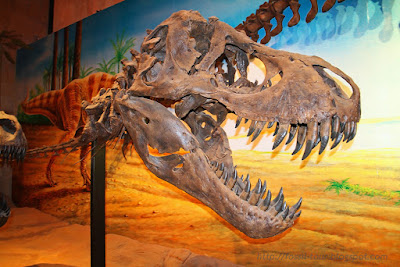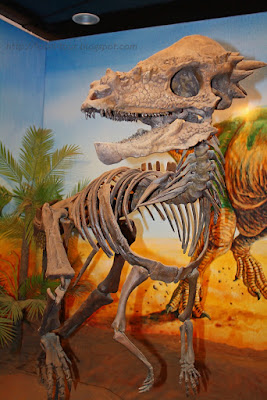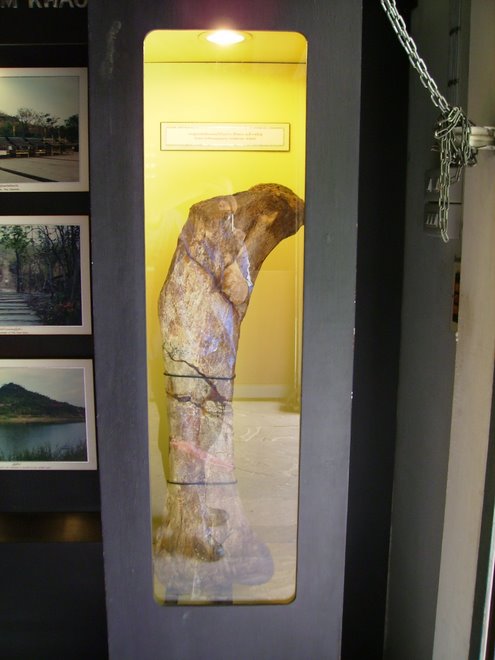Dinosaur Model @ Phu Kum Khao Dinosaur Museum
Northeastern Thailand During Mesozoic Era
During the early Mesozoic Era, Triassic, the northeastern part of Thailand had been covered by sea and consequently was uplifted forming mountains and volcanoes. However, many areas were subsided forming alluvial plains and fertile lakes. These lakes were full of algae, fishes, turtles and reptiles. Dinosaurs, prosauropod and sauropod, began to appear, the earliest sauropod was Isanosaurus attavipatchi.
In Jurassic, the climate was hot and dry but many regions of northeastern Thailand were still alluvial plains and swamps which were full of bivalves, fish the Lepidotes buddhabutrensis, crocodile the Sunosuchus thailandicus and dinosaur that began to evolve and increase in population such as sauropod, carnosaur, hypsilophodon and stegosaur.
During Late Jurassic to Early Cretaceous, northeastern Thailand became an extensive alluvial plain in which hundreds of rivers from Vietnam, Laos and Cambodia joined in the middle before flowing to the sea further in the west. There were several kinds of dinosaurs, Phuwianggosaurus sirindhornae, Siamotyrannus isanensis, Compsognathus, Kinareemimus etc, and later evolved to be Iguanodon and Psittacosaurus sattayaraki.
During the Late of Early Cretaceous, the Dong Phaya Yen mountain range was formed creating 2 landlocked basins, Nakhon Thai and Maha Sarakham, The basins consisted of extreme salty water from which potash and rock salt deposits formed. Consequently. the areas turned into dry land. Some of them were deserts. The dinosaurs might have become extinct either prior to the dry land stage or during the desert forming stage.
Dromaeosaurus sp.
Meaning - Running reptile, swift reptile
Order - Saurischia
Suborder - Theropoda
Family - Dromaeosauridae
Age - Late Cretaceous, 76 million years ago
Length - 2 m
Diet - animals, carrion
Locality - U.S.A. (Montana) and Canada (Alberta)
A herd of carnivorous dinosaurs
Dromaeosaur was a group of small-sized carnivorous dinosaurs with a big skull and eyes. Agile and fast running, it had robust legs, front claws and sickle-shaped hind claws. It overcame its prey by kicking, goring and leaving big wounds on the prey's body which died after losing blood. They might have travelled in herds helping each other hunt.
The dinosaurs in Dromaeosaur family were Dromaeosaurus, Deinonychus and Velociraptor.
Cenozoic Era
The Cenozoic Era or new era ranges from 65 million years ago until today and is divided into Paleogene and Neogene Periods.
Paleogene Period (65-23 million years)
There were 2 significant events during this period. The first one was the changing of climate from semiarid to arid. This resulted in transformation of tropical rainforest into grassland due to the cold current around Antarctica. It was formed during the separation of the Australian continent from the South American continent, creating ice sheet deposite on Antarctica. Another event was the dramatic increase of mammals which generated their diversity and they occupied the land, sea and sky. They were both carnivorous and herbivorous.This period is divided into Paleocene, Eocene and Oligocene
Neogene Period (23 million years - present)
This is the period towards the world of today. During the beginning of the period, all continents moved to their present position and the climate continuously cooled down. This resulted in the alternative ice age and warmer climate. The ancient mammals became extinct. Human ancestors started to evolve during the middle of the period prior to dissemination of their lineages.
This period is divided into Miocene, Pliocene, Pleistocene and Holocene.










































1 ความคิดเห็น:
I really appreciate your nice work that is making this blog exciting and amazing into the Dinosaur Model.
Thanks for the sharing a nice blog.
Dinosaur Model
Post a Comment